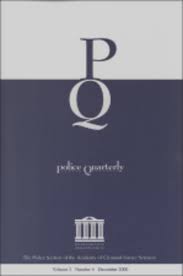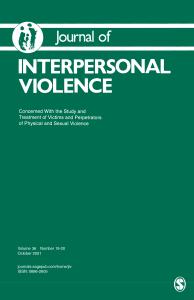Research
Current Faculty Research Projects
Age, race, and offense severity: an examination of the liberation hypothesis for juvenile case outcomes at final disposition
Project Purpose: To examine the individual and combined effects of a juvenile’s age, racial background, and offense severity on decision-making at final disposition.
Dr. Sara Bryson (with Dr. Jennifer Peck, University of Central Florida)
2021-2022
Recruitment and Retention Among NC Juvenile Justice Staff
Project Purpose: To assess the recruitment and retention of juvenile justice officers and juvenile court counselors in NC. Using data collected via survey from the population of juvenile justice officers, juvenile court counselors, and supervisors in the state, we examine how personal characteristics, work environment perceptions, and job attitudes predict outcomes such as turnover intent, job satisfaction, job burnout, and work stress, among others. We also examine any differences based on gender and supervisory status.
Dr. Heidi Bonner (with Mary Anne Werner, Department of Criminal Justice graduate student)
In partnership with the Criminal Justice Standards Division of the North Carolina Department of Justice
2018-2022
Comparing hate crime trends: UCR vs. NCVS
Project Purpose: To compare recent trends in bias crime between the Uniform Crime Reports (UCR) and the National Crime Victimization Survey (NCVS). The UCR has long been the primary source of official crime data in the United States, while the NCVS is viewed as a more accurate reflection of the number of crimes that occur in the nation. While it is well known that the number of bias crimes counted by the NCVS is considerably larger (~200,000 annually) than those counted by the UCR (~7,000 annually), this project seeks to examine the degree to which bias crime is trending in the same direction between the two data sources.
Dr. Michele Stacey
2021-2022
Etiology of youth criminal radicalization in southern Africa
Project Purpose: To evaluate the etiology of youth criminal radicalization including recruiting and indoctrination mechanisms involving criminal gangs, terrorists, and child soldering in Southern Africa. Social and environmental drivers, push, and pull factors will be analyzed to explain the methods used to involve minors in criminal and violent acts.
Dr. William Bloss (with Dr. Christiaan Bezuidenhout, University of Pretoria)
2022
The impact of teen court on juvenile recidivism, suspension, and perceptions of school climate
Project Purpose: To assess the benefits of Teen Court in addressing juvenile recidivism, suspensions, and school climate.
Dr. Sara Bryson (with Phillip Lewis, undergraduate student at East Carolina University)
2021-2022
Legality of police surveillance net widening
Project Purpose: To investigate the legality of expansive police surveillance methods in the US. Due to rapid advances in technology, law enforcement agencies have employed a broad range of surveillance and tracking applications under the aegis of criminal investigations. Recent scrutiny by federal courts has raised questions about the legality and violative privacy effects of several emerging police surveillance practices. The project aims to critically analyze these tracking methods in the context of evolving jurisprudence.
Dr. William Bloss
2022-2023
Recruitment and retention among NC probation officers
Project Purpose: To assess the recruitment and retention of community corrections officers in NC. Using data collected via survey from the population of probation/parole officers and supervisors in the state, we examine how personal characteristics, work environment perceptions, and job attitudes predict outcomes such as turnover intent, job satisfaction, job burnout, and work stress, among others. We also examine any differences based on gender and supervisory status.
Drs. Heidi Bonner and Mark Jones
In partnership with the Criminal Justice Standards Division of the North Carolina Department of Justice
2018-2022
Is it (cyber)bullying? Assessing adult perceptions of bullying and cyberbullying using a mixed-methods approach
Project Purpose: To investigate adults’ ability to identify bullying and cyberbullying and examines the rationale for why respondents identified – or not – instances of verbal, physical, and cyberbullying.
Dr. Sara Bryson (with Dr. Erica Fissel, University of Central Florida)
2021-2022
The use of PRINT in US probation supervision
Project Purpose: To assess the utility of PRINT, a personal resource inventory instrument, in assisting probation officers in the supervision of their clientele.
Dr. Mark Jones (with Dr. Leanne Alarid, University of Texas at El Paso)
In partnership with US Probation, Eastern District of North Carolina
2019-2022
Recruitment and Retention Among NC Institutional Corrections Staff
Project Purpose: To assess the recruitment and retention of adult institutional corrections officers in NC. Using data collected via survey from a stratified random sample of institutional corrections officers and supervisors in the state, we examine how personal characteristics, work environment perceptions, and job attitudes predict outcomes such as turnover intent, job satisfaction, job burnout, and work stress, among others. We also examine any differences based on gender, supervisory status, geographic location of institution, and custody level.
Dr. Heidi Bonner (with Ray McCarthy, Department of Criminal Justice graduate program alum and Art Beeler, Advisory Board member)
In partnership with the Criminal Justice Standards Division of the North Carolina Department of Justice
2018-2022
Publications
Criminal justice research methods

Criminal Justice Research Methods provides students with an accessible, easy-to-understand guide to all aspects of social scientific research methods. It features a comprehensive discussion of qualitative and quantitative data gathering strategies and a plethora of current examples to help readers understand the process of doing research and investigating issues that are relevant to criminal justice and criminology.
Dr. James Anderson
Cognella, 2022
ISBN-13: 978-1-5165-95471
Gender Differences in Law Enforcement Office Stress and Coping Strategies

Using survey data collected from a sample of law enforcement officers in a large urban police agency in the southeastern United States, this research examines the differences between male and female officers regarding the perception of stressors in policing and coping strategies used in response to stress. The results indicate that female officers have significantly higher mean stress scores on several items (particularly those regarding safety factors) and are considerably more likely to use positive coping strategies than male officers.
Dr. Heidi Bonner (with Dr. Andy Brimhall, ECU Department of Human Development and Family Science)
Police Quarterly, 2021
The effects of age, race, and offense type on receiving a “youth discount” in juvenile court

Using all individual referrals in a Southern state from 2010–2016, this study investigates the individual and joint effects of a juvenile’s age, race, and the handling of status offenders across petition and dispositional case outcomes. Results indicate that the youth discount applied at the petition stage but not disposition, and also suggest that race and offense type are more predictive of decision-making than the age of the juvenile.
Dr. Sara Bryson (with Dr. Jennifer Peck, University of Central Florida)
Journal of Crime and Justice, 2021
Veil of Darkness and Investigating Disproportionate Impact in Policing: When Researchers Disagree

Examines the impact of sampling decisions when using the Veil of Darkness methodology on the conclusions drawn regarding disproportionality in traffic stops by police.
Drs. Michele Stacey and Heidi Bonner
Police Quarterly, 2020
“Men Cannot Be Raped”: Correlates of Male Rape Myth Acceptance

This study examined rape myths, which are false beliefs that are widely accepted, contribute to the justification and normalization of sexual violence by offenders and focus on the actions and behavior of victims while minimizing the harm, for male victims. Individuals who adhered to female rape myths, held negative attitudes toward homosexuals, accepted traditional sexual double standards, and believed in traditional social gender roles were more likely to adhere to male rape myths which suggests that rape myths operate similarly regardless of the gender of the victim.
Dr. Scott Walfield
Journal of Interpersonal Violence, 2018
Mortality Rates and Cause of Death Among Former Prison Inmates in North Carolina

This research examines the mortality rates among recently released (6 months to one year) North Carolina prison inmates. Based on previous research we expected that recently released inmates die at a higher rate than the general population. This hypothesis was confirmed; for virtually every type of death, the former inmates die at a higher rate than the general population, including natural causes, poisoning (drug overdose), and suicide.
Dr. Mark Jones (with Dr. , East Carolina University, Dr. Xiaohui Xu, Texas A&M, Tammy Norwood, North Carolina Department of Health and Human Services, Scott K. Proescholdbell, North Carolina Department of Health and Human Services)
North Carolina Medical Journal, 2017
Criminological Theories

Criminological Theories: Understanding Crime in America explores crime, crime theory, and various forms of criminal behavior within the United States. It focuses exclusively on theory, avoiding superfluous discussion of the criminal justice system.
Dr. James Anderson
Jones and Bartlett Learning, 2015
ISBN: 9781449681876
Terrorism and organized crime: a protean connection

Analyzes the nexus between terrorism and organized crime. It provides a taxonomy of criminal group affiliations to explain the variations in relationship and cooperation among terrorist and organized crime actors.
Dr. William Bloss
Terrorism Research and Analysis Consortium, 2012
Under a watchful eye: privacy rights and criminal justice

Throwing light on a timely and controversial subject, this revealing book considers the privacy rights of alleged criminals, convicted criminals, crime victims, and justice personnel. It answers many crucial questions including what legal surveillance, search, and seizure authority do criminal justice officials have when investigating crimes, monitoring criminals, or regulating justice personnel?
Dr. William Bloss
Praeger Publishers, 2009
ISBN-13: 978-0-275-99406-8
Transforming US police surveillance in a new privacy paradigm

Examines the factors, legal doctrines, federal statutes, and operational practices that have enabled the police to widen their surveillance activities. As police utilize more technology and surveillance in crime control, their escalating search authority has led to a diminution in personal privacy safeguards.
Dr. William Bloss
Police Practice and Research: An International Journal, 2009
Consulting
The Department of Criminal Justice provides contractual research and development services to justice-related agencies.
Consulting
